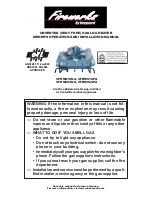
52
PRIOR TO START UP
Installation and start up of this water heater requires abilities
and skills equivalent to that of a licensed tradesman in the field
involved, see Qualifications on page 6.
Do not place the water heater in operation if any part has been
exposed to flooding or water damage. Immediately call a qualified
service technician to inspect the water heater and to replace any
part of the control system and any gas control which has been
under water.
Light the water heater in accordance with the Lighting and
Operation Instruction label on the water heater and in this manual
beginning on page 54.
The water heaters covered by this manual are equipped with an
electronic control system (see page 44) which automatically
sequences the Combustion Blower, pre and post purging of the
combustion chamber, the spark generator, the 24 Volt Gas Valve,
Main Burner ignition, and flame sensing. The control system will
lock out after three unsuccessful ignition attempts.
Before attempting start up, thoroughly study and familiarize
yourself with the exact Sequence Of Operation, see the written
Sequence Of Operation on page 56 and the Sequence Of
Operation Flow Chart on page 57.
Be certain that the water heater is full of water, that air is purged
from the gas and water lines and that there are no leaks in the
gas and water lines. Ensure all inlet water valves are open.
FILLING THE WATER HEATER
Follow these steps to fill the water heater prior to start up.
1. Close the heater drain valve.
2. Open a nearby hot water faucet to permit air in system to escape.
3. Fully open the cold water inlet valve allowing the piping and
water heater to fill with water.
4. Close the hot water faucet opened in Step 2 as water starts
to flow.
INITIAL START UP
REQUIRED TEST EQUIPMENT
• Two U-tube manometers, recommended ranges; 0-14” W.C.
(0-3.5 kPa) and 0-35” W.C. (0-8.7 kPa) or pressure gauges.
• Two digital manometers can be used in place of U-tube
manometers or pressure gauges. Recommended ranges;
-14.00 to +14.00” W.C. (0-3.5 kPa) resolution 0.01” W.C.
and 0-35” W.C. (0-8.7 kPa) resolution 0.10” W.C.
NOTE:
All test equipment must be acclimated to ambient
temperature before calibration and use.
PREPARATION
1. Using the control system menus, change the Operating Set
Point to the lowest temperature setting, see Operating Set
Point And Differential Adjustment on page 47.
2. Turn the water heater’s enable/disable switch to the
"disabled" position.
3. Close the Main Gas Shut Off Valve, see Figure 54 on
page 39.
4. Wait five (5) minutes for any residual gas to clear.
5. Connect one manometer (higher range) to an available test
port for the supply gas pressure to the water heater:
On the water heaters covered by this manual there are test
ports for supply and manifold gas pressure readings on
the gas valve. Using a small flat tip pocket screw driver -
open the needle valve inside the supply gas pressure test
port one full turn only; turn the needle valve screw counter-
clockwise to open the valve. Slide the manometer sensing
tube over the top of the test port, see Figure 60 and Figure
61.
6. Connect one manometer (lower range) to an available test
port for manifold gas pressure to the Main Burner:
Using a small flat tip pocket screw driver - open the
needle valve inside the manifold gas pressure test port
one full turn only; turn the needle valve screw counter-
clockwise to open the valve. Slide the manometer
sensing tube over the top of the test port, see Figure 60
and Figure 61.
7. Open the Main Gas Shutoff Valve.
8. Measure and record the supply gas pressure, this is a “static”
supply gas pressure reading; while the water heater is not
firing. Adjust supply gas pressure as necessary, see Supply
Gas Pressure Adjustment on page 54.
MANIFOLD GAS
PRESSURE
TEST PORT
SUPPLY GAS
PRESSURE
TEST PORT
GAS VALVE / VENTURI ASSEMBLY TOP VIEW
VENTURI
COMBUSTION
AIR INLET
GAS
VALVE
COMBUSTION
BLOWER
CONNECTION
Figure 60
MANIFOLD GAS
PRESSURE
TEST PORT
SUPPLY GAS
PRESSURE TEST PORT
GAS VALVE TOP DETAIL VIEW
Figure 61
GAS VALVE / VENTURI ASSEMBLY SIDE VIEW
VENTURI
LOW GAS
PRESSURE
SWITCH
SUPPLY GAS
CONNECTION
GAS
VALVE
COMBUSTION
AIR INLET
Figure 62
START UP
















































